Running burns a ton of calories, so do jump rope and plyometric exercises (think burpees, box jumps). But they’re also super high-impact. High-impact meaning that, at some point both your feet are in the air and you land back on terra firma with a resounding thump. Again. And again. And again. Case in point, when you run your body has to absorb an impact about two and a half times your body weight every time you take a step.12
But make no bones about it. High-impact exercise is a good thing. It puts the bones under stress, causing them to respond by becoming stronger, increasing bone density.345 Unfortunately, the repeated pounding can take a toll on the bones, joints, ligaments, and tendons. This may lead to injury, especially when the amount or intensity of training is increased too quickly or there is inadequate rest and recovery.678
Enter the low-impact workout. Low-impact exercise works the cardiorespiratory system (heart and lungs) just as hard as high-impact exercise, but nixes all that jumping and landing business. This means low-impact workouts place little biomechanical stress on the body. In other words, low-impact does what high-impact does, but without the strain on your joints.
Who Benefits from Low-Impact Workouts
In short, everyone. Everyone and anyone can benefit by including low-impact cardio in their training routine. Low-impact workouts are particularly beneficial:
- Injury. If you have been injured or are returning from injury, and can’t do your regular high-impact sport (e.g. running), low-impact activities can help you maintain fitness while sidelined.
If you have joint problems, an injury, or any other underlying musculoskeletal or medical conditions, remember to get the all clear from your doctor or physical therapist before starting exercise. They’ll advise which exercises to avoid and which activities may best reduce pain and increase function.
While the exercises below may be low-impact, they can be high-intensity. Therefore, start slowly. Gradually increase the duration, intensity or frequency of a workout, especially if you’ve been inactive.
Low-Impact, High-Intensity
Low-impact does not mean low-intensity. It’s easy to conflate impact (how hard you hit the ground) and intensity (how difficult an exercise feels). Go-hard-or-go-home, high-intensity workouts aren’t limited to high-impact sports such as running. Low-impact activities can be super tough too, burn a ton of calories and boost your heart health. So no need to sacrifice high-intensity for easy-on-the-joints, low-impact workouts. You can have your cake and eat it too.
In short, low-impact is not a step down from high-impact. Here’s the lowdown on low-impact activities that can deliver an incredible high-intensity workout and leave you with that oh-so-sweet runner’s high.
Stair Climbing
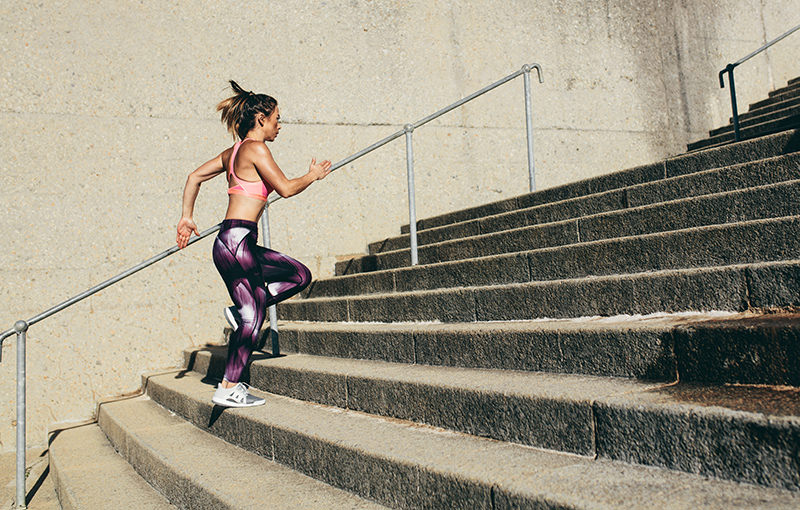
This workout will kick your butt and work up a serious sweat. Tougher than high-impact running, stair climbing will tone and strengthen your legs and seriously improve your cardiovascular fitness. There’s a reason no-one wants to take the stairs. Stair climbing will make you look forward to running.
Intensity: Climbing stairs burns the equivalent amount of calories as running a 10-minute mile.910Short, intense bouts of stair climbing boost cardiorespiratory fitness and can reduce LDL (bad) cholesterol.1112
Muscles: Stair climbing targets the core, glutes, thighs and calves. Taking two steps at a time (or bigger steps on a stair climber) makes the workout more challenging and also works the glutes and front of thighs harder.13
Where: You can climb real stairs indoors or out, or use a stair climbing machine. Complete a stair climbing workout in one session or break it up and do it throughout the day (e.g. taking the stairs instead of the elevator).
How: Whichever option you choose, maintain good posture. Keep your trunk upright and core engaged. Avoid hunching or learning too far forward. Your neck and shoulders should be relaxed. Place the whole of your foot on the step and push down through your heels as well as the balls of your feet, so that you work all your leg muscles as effectively as possible.
Read more: Ultimate strength- and cardio workout: Stair-climbing
Cycling & Spinning
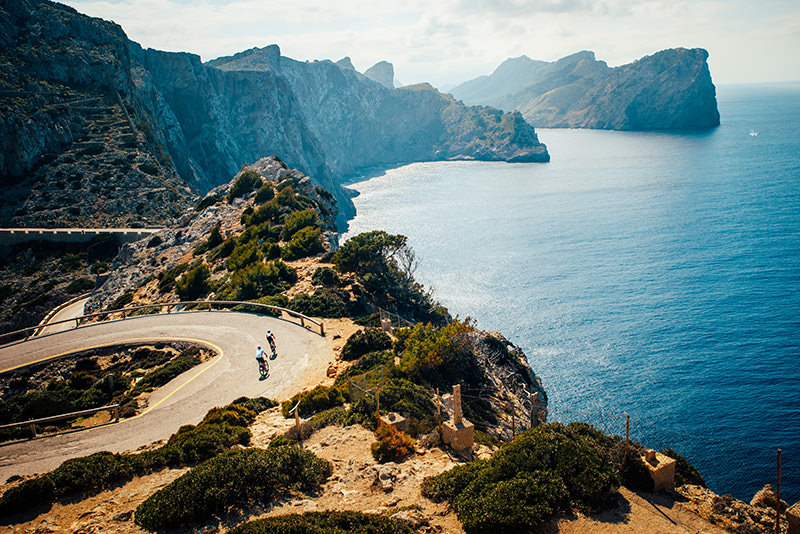
If you’ve ever been to a spinning class, you know. You know spinning can make every other workout look like a walk in the park. The great thing about cycling is that it’s for everyone. Indoors or out. Solitary or social. For fitness or to actually get somewhere. Mountain bike, road bike, folding bike, or stationary bike. There’s a bike and a tribe for every personality.
Intensity: Spinning is a high-intensity workout that burns a large number of calories and is an effective way to lose weight.141516 Outdoor cycling can be just as good. The main difference is that there’s no instructor motivating you to push hard, so it’s up to you to keep up the intensity. The good news is that when you’re in the great outdoors you’re less prone to fatigue and more likely to exercise harder compared to cycling indoors.1718
Where: Cycling is an incredible exercise whether you ride outdoors, use a stationary exercise bike, or love yourself a spinning class. Cycling indoors is practical and spinning is a fast and furious stress-relieving workout. When you hit the outdoors and head for nature you reap an abundance of physical and psychological health benefits.1920
Muscles: Cycling gives all the major muscles of the lower body a tough workout, especially when you crank up the resistance. Cycling outdoors also targets the core muscles, which work to keep you balanced and stable on the bike. However, unlike many of the other low-impact activities cycling does not target the upper body.
How: Whether you cycle indoors or out, ride with good form and set up your bike to fit you properly. This ensures you are able to move efficiently and stay comfortable. It will also reduce the likelihood of overuse injuries.2122
If you’re new to cycling, start out slowly and gradually increase the length, intensity, and resistance. Cycling is relatively easy on the joints, but the repetitive pedaling motion can cause knee pain if you abruptly increase the difficulty and overdo things.232425
Be mindful: Cycling is suitable for all ages and fitness levels. However, spinning is a strenuous workout that requires some degree of fitness.26 If you’ve been inactive for some time, begin with moderate exercise. If you cycle outdoors always wear a helmet and bright, high-visibility clothing.
Read on: Beginner’s guide to cycling
Rowing
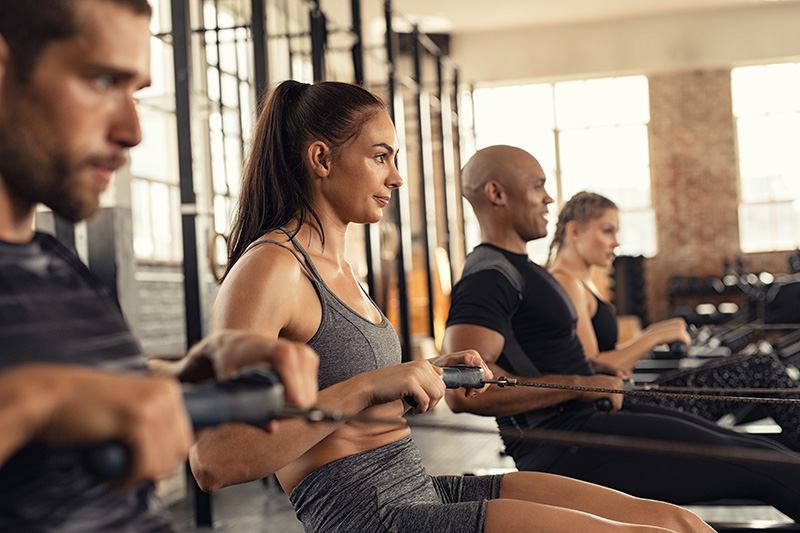
Rowing is about as tough a workout as it gets. More than that, rowing does it all. Both a strength and an endurance exercise, it works just about every muscle in your body and is completely impact-free.2728
Muscles: Rowing strengthens your glutes, legs, arms, core, and back, and also increases endurance of the heart and lungs. In other words, you’re getting an incredible cardio workout, but also doing strength moves that are similar to heavy duty exercises such as deadlifts, seated rows, and calf raises.
Where: You can row indoors on a rowing machine or outdoors (if you have access to a boat and a large body of water). Work out alone or keep it social. In recent years rowing has grown in popularity, with motivational group exercise classes and rowing-specific studios similar to SoulCycle springing up.
How: Rowing isn’t difficult to master, but takes a little practice. It you’re new to rowing, start with a 10-minute workout. Gradually increase resistance, intensity and time as you as you get accustomed to the movement and to avoid early overuse. Remember to allow for adequate rest and recovery.29
Be mindful: It’s important to row using good technique to prevent injury, especially of the lower back. A common mistake is to round the back and slump forward, which stresses the lower back and exposes it to injury.30
Read more: Why you need to practice proper form
Hill Walking
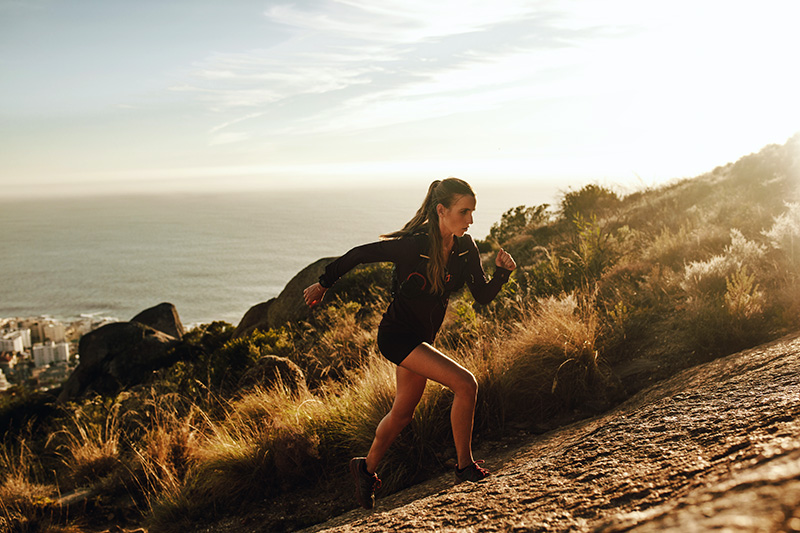
Walking is low-impact, free, and boasts a list of health benefits too long to mention (especially outdoors).3132 Switch up your walk by increasing the incline and you’ve got yourself a super challenging cardiovascular and strength workout.
Intensity: Walking uphill is more demanding and burns more calories, because the muscles have to do more work to propel you forward, as well as upward against gravity. Indeed, walking up a hill with a 10% incline at a brisk pace of 3.4 mph burns about the same amount of calories as jogging. That’s more than double the calories than walking on level ground.3334
Muscles: Walking uphill works the lower body muscles harder. The glutes, quadriceps (front of thigh muscles), and calves get a more intense workout than walking on the flat.35 You also use the muscles of your core and arms more, as you lean forward slightly to help propel yourself up the hill.
Where: You can walk uphill using a treadmill. Most treadmills can increase the incline up to 15%. Alternatively, find your nearest hill and walk in your neighborhood. Another option is to leave your urban surroundings behind and immerse yourself in nature. It doesn’t get much better than hiking up a hill with picturesque surroundings and being rewarded with uninterrupted views at the top.
How: When you head outside, try hill repeats – walk uphill at a brisk pace and recover as you slowly walk back down. This makes for a great interval workout and has the added benefit of protecting the knees from the increased strain of walking downhill.36
Be mindful: If you like the treadmill, crank up the incline. But no holding onto the handrails to help propel you forward; that only makes your workout less effective. Set the treadmill at a speed and incline at which you can safely walk without holding on.
Read more: How to lose weight walking
Swimming

Swimming is the ultimate low-impact workout. Not just cardiovascular exercise, swimming builds muscle strength as you fight against the resistance of the water, which is about 800 times more dense than air. No need to turn up the resistance on this one – it’s built in.
Exercising in water creates a unique workout environment and has many benefits:
- The water supports the majority of your body weight, which takes the stress off your joints and improves range of movement.
Intensity: Swimming as a workout is challenging. For example, the butterfly is one most intense movements in all of sport, burning more calories than running a 10-minute mile.
Muscles: Swimming strengthens every major muscle in your body, whether you swim freestyle, breaststroke or butterfly. Pulling your body through the water works the back and shoulders, while kicking your legs strengthens your chest, butt, and thighs. And your core works keeps the whole thing together by holding your body up, keeping you balanced, and maintaining good form in the water.
Still, each stroke emphasizes slightly different muscle groups. Therefore, include a variety of different strokes for a fully rounded workout.
How: Swim steady-state or try interval training. Use a kickboard, pull buoy, or aqua weights to strengthen different body parts. If you’re a good swimmer but haven’t been swimming for exercise, work on improving your technique and increasing endurance. Slowly build up to swimming 30 minutes at a time.
You can take swimming lessons if you can’t swim or you’re not confident about your swimming abilities. There are a variety of adult swimming lessons available. It’s never too late! Swimming is valuable life skill that can save a life; and it can open up a whole new world of water-sports.
Be mindful: When swimming, heart rate tends to be lower compared to land-based activities.3738 This means your heart rate may suggest you’re exercising at a lower intensity, when you’re actually working out more vigorously. Therefore, also take perceived exertion (RPE) into account.
Read more: Beginner Guide To Swimming Workouts
Elliptical Machine
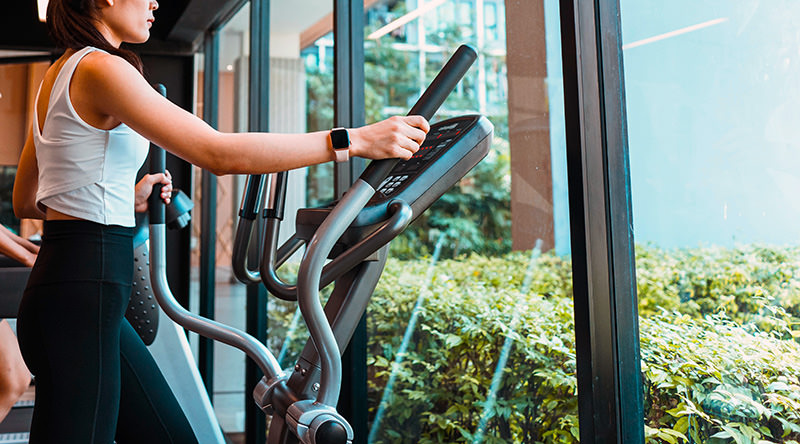
Elliptical machines mimic running but eliminate the impact, making it a superb alternative to the treadmill.3940 This non-impact, weight-bearing exercise also feels easier than other workouts.41
Intensity: Exercising on the elliptical results in similar improvements of metabolic and cardiorespiratory fitness as on running the treadmill.42 It also burns just as many calories when exercising at the same perceived intensity (RPE).43
Muscles: The elliptical offers the advantage of being a total body workout. Pushing and pulling the arm handles strengthens the muscles of the upper body including the biceps, triceps, and shoulder muscles. The striding action works the lower body, and balancing the movements of the upper and lower body targets the core muscles.
How: Aim for a faster pace with low resistance for a running-like cardio workout. Crank up to resistance and slow the pace for a more muscle-building workout. Change the resistance and incline to target different parts of your body more, do a steady-state workout, or go all out and do HIIT. On the elliptical the variety is endless.
For an effective workout:
- Adjust the pace and resistance so you can feel that you’re pushing and pulling through every stride.
- It’s important to remain focused on maintaining the desired exercise intensity – throughout the workout. This is because the elliptical only goes as fast as you move your arms and legs, which is in contrast to the treadmill where you set the speed and then simply run to keep up with it (or else you fall off!). In other words, you have to purposefully work hard, as opposed to passively keeping up.
Be mindful: Exercising on the elliptical feels easier, which means you may be exercising more vigorously that you think.44 Therefore, also take your heart rate into consideration.
Read more: How to get a great workout on the elliptical
Circuit Training Workouts
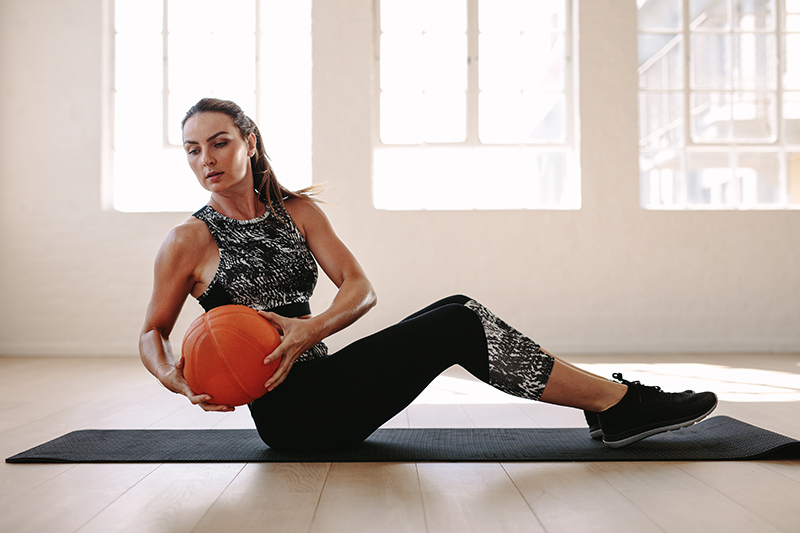
Moving quickly from one strength training exercise to the next for a series of 6 or more moves is a great way to get a total body strength and cardio workout; all without actually having to do any recognizable cardio-type exercises.45 So if you hate cardio – circuit-training is for you.
Circuit training has multiple benefits. Being both a cardio and strength workout, circuit training is able to reduce BMI and body fat, while simultaneously increasing lean muscle mass.46 Research shows that it may also improve insulin resistance, cardiometabolic risk factors, and pancreatic function in type 2 diabetes.4748
Intensity: Circuit training is often performed at a brisk pace, with little or no rest between exercises. It’s a high intensity workout. However, you can slow things down and take longer breaks to reduce the intensity.
Muscles: Compound, multi-joint, and full-body exercises work a bunch of muscles simultaneously (such as squats, lunges, push-ups and shoulder presses). This keeps the workout challenging and ensures a total body workout in a very short time.
Where: Circuit training makes for an excellent at-home workout. You can also do group circuit training classes at most gyms or your local CrossFit.
How: Arrange your workout in a push/ pull/ legs sequence (i.e. upper body pushing muscles – chest, shoulders, and triceps / upper body pulling muscles – back and biceps / lower body – thighs, calves and abdominals). Perform each exercise for a specific time or pre-determined number of reps, as preferred.
If you’re following a circuit with high-impact cardio exercises such as burpees and jumping jacks, swap them out for low-impact moves instead (e.g. marching in place, step ups, one leg kicks, stand and box, bear crawl, stepping jacks, and jump-free burpees).
Be mindful: Slow the pace of the workout if you’re not familiar with the moves or struggling to keep up. It is important that you execute each exercise with good form for maximum effectiveness and to avoid injury. That means making the right movements, as well as engaging the right muscles at the right time (e.g. pulling your belly button in towards your spine). No fudging allowed!
Boxing Workouts
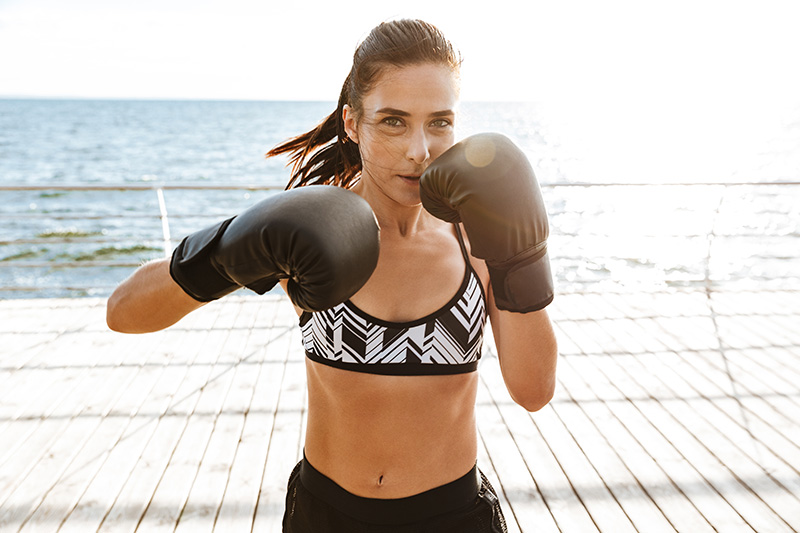
Boxing-style workouts are low-impact on the lower body. However, punching a bag does put a fair bit of impact though your hands, wrists, arms and shoulders. This has positive effects on bone strength, as boxing is associated with higher levels of bone density.49
A combination of cardio (you’re constantly moving) and strength training (your punches), it’s a fantastic stress buster and a good way to get fit.
Muscles: Boxing is a total body workout, targeting the core, chest, shoulders, and legs. Every time you hit the bag you have to engage your whole body, to stabilize your body and control your movements.
How: Set a timer and punch for 3 minutes and then rest for 1 minute – just like a real boxer. Keep moving your feet and switching your punches from high to low. Don’t try and make every punch a knockout, as you’ll soon get tired!
Be mindful: Always wear hand wraps and boxing gloves to protect your hands. And never punch with bent wrists or your thumbs tucked inside your fists. Avoid boxing if you have any upper body issues.
Aerobics
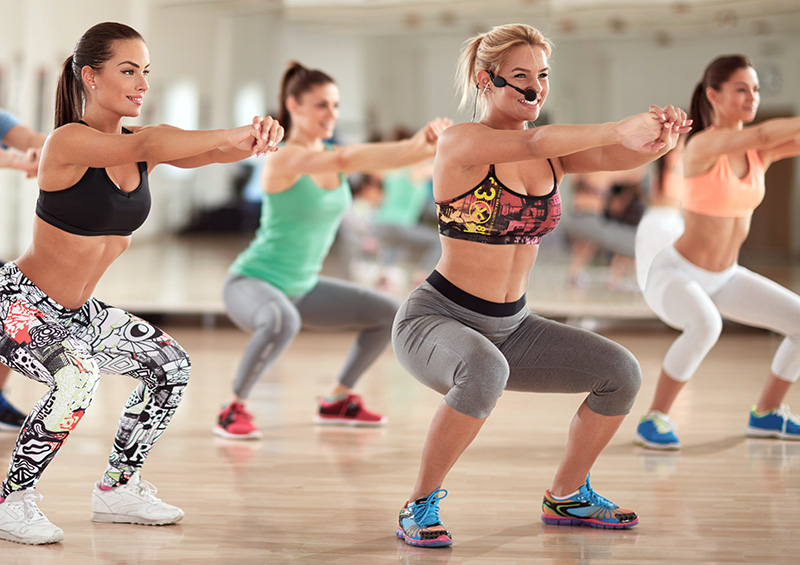
Whether you like step, jazz, latin, salsa, funk-fusion, hip-hop, jazz, cardio box, and more – there’s an aerobics class for everyone. Perennially popular, aerobics is about music, movement, and rhythm. It’s fun, motivational, and energetic. Research suggests that aerobics can boost cardiovascular fitness, reduce body fat, improve blood cholesterol, and exert positive effects on mood.505152
Intensity: Workout intensity varies according the class (beginner, intermediate, and advanced). Increasing the pace or adding weights increases the intensity. Raising the height of the step, if you’re doing step aerobics, also makes the class more challenging.
Muscles: Aerobics targets the arms, legs, glutes, core, and back. Some classes add weights, to work the muscles harder and increase workout intensity.
Where: Watch an aerobic exercise video and work out in the comfort and privacy of your home. Alternatively, check out your local gym or studio for low-impact aerobics classes.
How: Grapevines, marching on the spot, squats, half jacks and lunges are all common moves in low-impact aerobics classes. The golden rule of low-impact aerobics is that you always keep one foot on the ground or step.
Be mindful: Generally, aerobics tends be quite suitable for exercisers looking for an effective and demanding, but low-impact workout. Although some aerobics moves involve jumping, many are low-impact. Speak to the instructors who will provide a low impact alternative to make the classes accessible to everyone. There are also classes that are specifically low impact.
Good Bone Health
For a well-rounded cardio routine and good bone health, be sure to incorporate regular weight-bearing exercise into your training program.5354
Weight-bearing exercises are those where you have to work against gravity and are supporting your entire body weight (e.g. walking, running, climbing stairs, and aerobics). Non-weight bearing activities tend to be those where you’re sitting down or floating, such as cycling, swimming, and rowing. These activities put a negligible amount of pressure on your skeleton and do not strengthen the bones.55
Low-impact workouts can be just as effective as high-impact exercise to increase cardiorespiratory fitness, burn calories, and improve overall health. It allows you to get or stay fit without the repeated stress on your joints.
A final note for beginners. Don’t swear off high-impact workouts forever if you’ve just started exercising and absolutely hated it. Build muscle and strengthen your joints with lower-impact exercise. This prepares your body for more strenuous high-impact workouts. You’ll find high-impact exercise easier and it’ll reduce the risk of injury.
Alternatively, include a little high-impact activity into an otherwise low-impact workout. For example, try a run-walk plan that mixes walking with intervals of running, building up to running entirely for 20 minutes.
- Ainsworth BE, Haskell WL, Herrmann SD, et al. 2011 Compendium of Physical Activities: a second update of codes and MET values. Med Sci Sports Exerc.2011;43(8):1575-81. DOI: 10.1249/MSS.0b013e31821ece12. PMID: 21681120.
- Alcaraz PE, Sánchez-Lorente J, Blazevich AJ. Physical performance and cardiovascular responses to an acute bout of heavy resistance circuit training versus traditional strength training. J Strength Cond Res. 2008;22(3):667-71. DOI: 10.1519/JSC.0b013e31816a588f. PMID: 18438256.
- Alexander N, Strutzenberger G, Ameshofer LM, Schwameder H. Lower limb joint work and joint work contribution during downhill and uphill walking at different inclinations. J Biomech. 2017;61:75-80. DOI: 10.1016/j.jbiomech.2017.07.001. PMID: 28734544.
- Allison MK, Baglole JH, Martin BJ, et al. Brief Intense Stair Climbing Improves Cardiorespiratory Fitness. Med Sci Sports Exerc. 2017;49(2):298-307. DOI: 10.1249/MSS.0000000000001188. PMID: 28009784.
- American Academy of Orthopaedic Surgeons (AAOS). Stress Fractures. Orthoinfo. Available from:orthoinfo.aaos.org/en/diseases–conditions/stress-fractures/.
- American College of Sports Medicine (ACSM). ACSM’s Resources for the Personal Trainer. 4th ed. Philadelphia: Wolters Kluwer Health, 2014. ISBN: 9781469826578.
- Astur DC, Zanatta F, Arliani GG, et al. Stress fractures: definition, diagnosis and treatment. Rev Bras Ortop. 2015;51(1):3-10. DOI: 10.1016/j.rboe.2015.12.008. PMID: 26962487.
- Babatunde OO, Jordan JL, Van der Windt DA, et al. Effective treatment options for musculoskeletal pain in primary care: A systematic overview of current evidence. PLoS One.2017;12(6):e0178621. DOI: 10.1371/journal.pone.0178621. PMID: 28640822.
- Barker AL, Talevski J, Morello RT, et al. Effectiveness of aquatic exercise for musculoskeletal conditions: a meta-analysis. Arch Phys Med Rehabil. 2014;95(9):1776-86. DOI: 10.1016/j.apmr.2014.04.005. PMID: 24769068.
- Barton J, Pretty J. What is the best dose of nature and green exercise for improving mental health? A multi-study analysis. Environ Sci Technol. 2010;44(10):3947-55. DOI: 10.1021/es903183r. PMID: 20337470.
- Batté AL, Darling J, Evans J, et al. Physiologic response to a prescribed rating of perceived exertion on an elliptical fitness cross-trainer. J Sports Med Phys Fitness. 2003;43(3):300-5. PMID: 14625510.
- Battista RA, Foster C, Andrew J, et al. Physiologic responses during indoor cycling. J Strength Cond Res. 2008;22(4):1236-41. DOI: 10.1519/JSC.0b013e318173dbc4. PMID: 18545183.
- Becker BE. Aquatic therapy: scientific foundations and clinical rehabilitation applications. PM R.2009;1(9):859-72. DOI: 10.1016/j.pmrj.2009.05.017. PMID: 19769921.
- Berger BG, Owen DR. Mood alteration with yoga and swimming: aerobic exercise may not be necessary. Percept Mot Skills. 1992;75(3 Pt 2):1331-43. DOI: 10.2466/pms.1992.75.3f.1331. PMID: 1484805.
- Bianco A, Bellafiore M, Battaglia G, et al. The effects of indoor cycling training in sedentary overweight women. J Sports Med Phys Fitness. 2010;50(2):159-65. PMID: 20585293.
- Bini RR, Flores Bini A. Potential factors associated with knee pain in cyclists: a systematic review. Open Access J Sports Med. 2018;9:99-106. DOI: 10.2147/OAJSM.S136653. PMID: 29872355.
- Boreham CA, Kennedy RA, Murphy MH, et al. Training effects of short bouts of stair climbing on cardiorespiratory fitness, blood lipids, and homocysteine in sedentary young women. Br J Sports Med. 2005;39(9):590-3. DOI: 10.1136/bjsm.2002.001131. PMID: 16118293.
- Bosomworth NJ. Exercise and knee osteoarthritis: benefit or hazard? Can Fam Physician. 2009;55(9):871-8. PMID: 19752252.
- Brown GA, Cook CM, Krueger RD, Heelan KA. Comparison of energy expenditure on a treadmill vs. an elliptical device at a self-selected exercise intensity. J Strength Cond Res. 2010;24(6):1643-9. DOI: 10.1519/JSC.0b013e3181cb2854. PMID: 20453685.
- Bus SA. Ground reaction forces and kinematics in distance running in older-aged men. Med Sci Sports Exerc. 2003;35(7):1167-75. DOI: 10.1249/01.MSS.0000074441.55707.D1. PMID: 12840638.
- Caria MA, Tangianu F, Concu A, et al. Quantification of Spinning bike performance during a standard 50-minute class. J Sports Sci. 2007;25(4):421-9. DOI: 10.1080/02640410600718533. PMID: 17365529.
- Cavanagh PR, Lafortune MA. Ground reaction forces in distance running. J Biomech.1980;13(5):397-406. doi: 10.1016/0021-9290(80)90033-0. PMID: 7400169.
- Centers for Disease Control and Prevention (CDC). Benefits of Physical Activity. Available from: cdc.gov/physicalactivity/basics/pa-health/index.htm.
- Centers for Disease Control and Prevention (CDC). Health Benefits of Water-based Exercise. Available from: cdc.gov/healthywater/swimming/swimmers/health_benefits_water_exercise.html.
- Centers for Disease Control and Prevention (CDC). Joint Pain and Arthritis. Available from: cdc.gov/arthritis/pain/.
- Centers for Disease Control and Prevention (CDC). Physical Activity for Arthritis. Available from: cdc.gov/arthritis/basics/physical-activity-overview.html.
- DiCarlo LJ, Sparling PB, Millard-Stafford ML, Rupp JC. Peak heart rates during maximal running and swimming: implications for exercise prescription. Int J Sports Med. 1991;12(3):309-12. DOI: 10.1055/s-2007-1024687. PMID: 1889941.
- Dugan SA. Sports-related knee injuries in female athletes: what gives? Am J Phys Med Rehabil.2005;84(2):122-30. DOI: 10.1097/01.phm.0000154183.40640.93. PMID: 15668560.
- Egaña M, Donne B. Physiological changes following a 12 week gym based stair-climbing, elliptical trainer and treadmill running program in females. J Sports Med Phys Fitness. 2004;44(2):141-6. PMID: 15470311.
- Farrell KC, Reisinger KD, Tillman MD. Force and repetition in cycling: possible implications for iliotibial band friction syndrome. Knee. 2003;10(1):103-9. DOI: 10.1016/s0968-0160(02)00090-x. PMID: 12649036.
- Fealy CE, Nieuwoudt S, Foucher JA, et al. Functional high-intensity exercise training ameliorates insulin resistance and cardiometabolic risk factors in type 2 diabetes. Exp Physiol. 2018;103(7):985-994. DOI: 10.1113/EP086844. PMID: 29766601.
- Foster C, Hector LL, Welsh R, et al. Effects of specific versus cross-training on running performance. Eur J Appl Physiol Occup Physiol. 1995;70(4):367-72. DOI: 10.1007/BF00865035. PMID: 7649149.
- Francis P, Whatman C, Sheerin K, et al. The Proportion of Lower Limb Running Injuries by Gender, Anatomical Location and Specific Pathology: A Systematic Review. J Sports Sci Med. 2019;18(1):21-31. PMID: 30787648.
- Gladwell VF, Brown DK, Wood C, et al. The great outdoors: how a green exercise environment can benefit all. Extrem Physiol Med. 2013;2(1):3. DOI: 10.1186/2046-7648-2-3. PMID: 23849478.
- Gottschall JS, Aghazarian GS, Rohrbach EA. The metabolic and muscular differences between two stair-climbing strategies of young adults. J Strength Cond Res. 2010;24(9):2558-63. DOI: 10.1519/JSC.0b013e3181e83a6f. PMID: 20703160.
- Hauber C, Sharp RL, Franke WD. Heart rate response to submaximal and maximal workloads during running and swimming. Int J Sports Med. 1997;18(5):347-53. DOI: 10.1055/s-2007-972644. PMID: 9298774.
- Heinonen A, Kannus P, Sievänen H, et al. Randomised controlled trial of effect of high-impact exercise on selected risk factors for osteoporotic fractures. Lancet. 1996;348(9038):1343-7. DOI: 10.1016/S0140-6736(96)04214-6. PMID: 8918277.
- Higgins S, Fedewa MV, Hathaway ED, et al. Sprint interval and moderate-intensity cycling training differentially affect adiposity and aerobic capacity in overweight young-adult women. Appl Physiol Nutr Metab. 2016;41(11):1177-1183. DOI: 10.1139/apnm-2016-0240. PMID: 27806634.
- Hopker J, Jobson S. Performance Cycling: The Science of Success. London: Bloomsbury Publishing; 2012. ISBN: 9781408196472.
- Kaplan Y, Barak Y, Palmonovich E, Nyska M, Witvrouw E. Referent body weight values in over ground walking, over ground jogging, treadmill jogging, and elliptical exercise. Gait Posture. 2014;39(1):558-62. DOI: 10.1016/j.gaitpost.2013.09.004. PMID: 24095267.
- Kennedy MM, Newton M. Effect of exercise intensity on mood in step aerobics. J Sports Med Phys Fitness. 1997 Sep;37(3):200-4. PMID: 9407751.
- Klomsten Andersen O, Clarsen B, Garthe I, et al. Bone health in elite Norwegian endurance cyclists and runners: a cross-sectional study. BMJ Open Sport Exerc Med.2018;4(1):e000449. DOI: 10.1136/bmjsem-2018-000449. PMID: 30687513.
- Lavin KM, Guenette JA, Smoliga JM, Zavorsky GS. Controlled-frequency breath swimming improves swimming performance and running economy. Scand J Med Sci Sports. 2015;25(1):16-24. DOI: 10.1111/sms.12140. PMID: 24151982.
- Lee IM, Shiroma EJ, Kamada M, et al. Association of Step Volume and Intensity With All-Cause Mortality in Older Women. JAMA Intern Med. 2019;179(8):1105–12. DOI: 10.1001/jamainternmed.2019.0899. PMID: 31141585.
- Lu TW, Chien HL, Chen HL. Joint loading in the lower extremities during elliptical exercise. Med Sci Sports Exerc.2007;39(9):1651-8. DOI: 10.1249/mss.0b013e3180dc9970. PMID: 17805099.
- Mäestu J, Jürimäe J, Jürimäe T. Monitoring of performance and training in rowing. Sports Med. 2005;35(7):597-617. DOI: 10.2165/00007256-200535070-00005. PMID: 16026173.
- Mieras ME, Heesch MW, Slivka DR. Physiological and psychological responses to outdoor vs. laboratory cycling. J Strength Cond Res. 2014;28(8):2324-9. DOI: 10.1519/JSC.0000000000000384. PMID: 24476776.
- Mosher PE, Ferguson MA, Arnold RO. Lipid and lipoprotein changes in premenstrual women following step aerobic dance training. Int J Sports Med. 2005;26(8):669-74. DOI: 10.1055/s-2004-830437. PMID: 16158373.
- Murphy MH, Nevill AM, Murtagh EM, Holder RL. The effect of walking on fitness, fatness and resting blood pressure: a meta-analysis of randomised, controlled trials. Prev Med. 2007;44(5):377-85. DOI: 10.1016/j.ypmed.2006.12.008. PMID: 17275896.
- National Institutes of Health Osteoporosis and Related Bone Diseases. Exercise for Your Bone Health. 2018. Available from: bones.nih.gov/health-info/bone/bone-health/exercise/exercise-your-bone-health.
- Nieuwoudt S, Fealy CE, Foucher JA, et al. Functional high-intensity training improves pancreatic β-cell function in adults with type 2 diabetes. Am J Physiol Endocrinol Metab. 2017;313(3):E314-E320. DOI: 10.1152/ajpendo.00407.2016. PMID: 28512155.
- Øiestad BE, Østerås N, Frobell R, et al. Efficacy of strength and aerobic exercise on patient-reported outcomes and structural changes in patients with knee osteoarthritis: study protocol for a randomized controlled trial. BMC Musculoskelet Disord. 2013;14:266. DOI: 10.1186/1471-2474-14-266. PMID: 24028201.
- Pennebaker JW, Lightner JM. Competition of internal and external information in an exercise setting. J Pers Soc Psychol. 1980;39(1):165-74. DOI: 10.1037/0022-3514.39.1.165. PMID: 7411392.
- Pickle NT, Grabowski AM, Auyang AG, Silverman AK. The functional roles of muscles during sloped walking. J Biomech. 2016;49(14):3244-3251. DOI: 10.1016/j.jbiomech.2016.08.004. PMID: 27553849.
- Pöyhönen T, Sipilä S, Keskinen KL, et al. Effects of aquatic resistance training on neuromuscular performance in healthy women. Med Sci Sports Exerc. 2002;34(12):2103-9. PMID: 12471323.
- Rector RS, Rogers R, Ruebel M, et al. Lean body mass and weight-bearing activity in the prediction of bone mineral density in physically active men. J Strength Cond Res. 2009;23(2):427-35. DOI: 10.1519/JSC.0b013e31819420e1. PMID: 19197207.
- Rumball JS, Lebrun CM, Di Ciacca SR, Orlando K. Rowing injuries. Sports Med.2005;35(6):537-55. DOI: 10.2165/00007256-200535060-00005. PMID: 15974636.
- Salai M, Brosh T, Blankstein A, et al. Effect of changing the saddle angle on the incidence of low back pain in recreational bicyclists. Br J Sports Med.1999;33(6):398-400. DOI: 10.1136/bjsm.33.6.398. PMID: 10597848.
- Secher N. Rowing. In: Reilly T, Secher N, Snell P, Williams C. (eds.) Physiology of Sports. United Kingdom: Taylor & Francis, 2005. DOI: doi.org/10.4324/9780203013311.
- Sperlich B, Wallmann-Sperlich B, Zinner C, et al. Functional High-Intensity Circuit Training Improves Body Composition, Peak Oxygen Uptake, Strength, and Alters Certain Dimensions of Quality of Life in Overweight Women. Front Physiol. 2017;8:172. DOI: 10.3389/fphys.2017.00172. PMID: 28420999.
- Sutton K. Top five tips for getting through a sports injury. American Academy of Orthopaedic Surgeons (AAOS). Available from: orthoinfo.aaos.org/en/recovery/ortho-pinion-top-five-tips-for-getting-through-a-sports-injury/.
- Swain D, Brawner C, Chambliss H, et al. ACSM’s Resource Manual for Guidelines for Exercise Testing and Prescription. Philadelphia: Wolters Kluwer Health/Lippincott Williams & Wilkins, 2014. ISBN: 9781609139568.
- Teh KC, Aziz AR. Heart rate, oxygen uptake, and energy cost of ascending and descending the stairs. Med Sci Sports Exerc. 2002;34(4):695-9. DOI: 10.1097/00005768-200204000-00021. PMID: 11932581.
- Thornton JS, Vinther A, Wilson F, et al. Rowing Injuries: An Updated Review. Sports Med. 2017;47(4):641-661. DOI: 10.1007/s40279-016-0613-y. PMID: 27577685.
- Tomas-Carus P, Gusi N, Häkkinen A, et al. Eight months of physical training in warm water improves physical and mental health in women with fibromyalgia: a randomized controlled trial. J Rehabil Med. 2008;40(4):248-52. DOI: 10.2340/16501977-0168. PMID: 18382819.
- Torres-Ronda L, Del Alcázar XS. The Properties of Water and their Applications for Training. J Hum Kinet. 2014;44:237-48. DOI: 10.2478/hukin-2014-0129. PMID: 25713684.
- Trutschnigg B, Chong C, Habermayerova L, et al. Female boxers have high bone mineral density despite low body fat mass, high energy expenditure, and a high incidence of oligomenorrhea. Appl Physiol Nutr Metab. 2008;33(5):863-9. DOI: 10.1139/H08-071. PMID: 18923560.
- Tucker LA, Strong JE, LeCheminant JD, Bailey BW. Effect of two jumping programs on hip bone mineral density in premenopausal women: a randomized controlled trial. Am J Health Promot. 2015;29(3):158-64. DOI: 10.4278/ajhp.130430-QUAN-200. PMID: 24460005.
- Vendramin B, Bergamin M, Gobbo S, et al. Health Benefits of Zumba Fitness Training: A Systematic Review. PM R. 2016;8(12):1181-1200. DOI: 10.1016/j.pmrj.2016.06.010. PMID: 27317918.
- Wanich T, Hodgkins C, Columbier JA, et al. Cycling injuries of the lower extremity. J Am Acad Orthop Surg. 2007;15(12):748-56. DOI: 10.5435/00124635-200712000-00008. PMID: 18063715.
- Willick SE, Hansen PA. Running and osteoarthritis. Clin Sports Med. 2010;29(3):417-28. DOI: 10.1016/j.csm.2010.03.006. PMID: 20610030.
- Yeow CH, Ng KS, Cheong CH, et al. Repeated application of incremental landing impact loads to intact knee joints induces anterior cruciate ligament failure and tibiofemoral cartilage deformation and damage: A preliminary cadaveric investigation. J Biomech. 2009;42(8):972-81. DOI: 10.1016/j.jbiomech.2009.03.026. PMID: 19380143.

